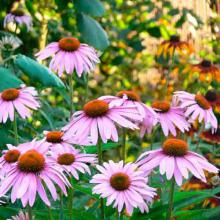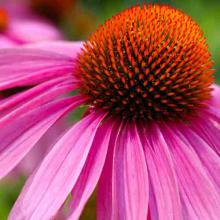Echinacea angustifolia
Common name:
Blacksamson echinacea
Genus:
Echinacea
Family:
Asteraceae
Order:
Asterales
Echinacea purpurea
Common name:
Purple coneflower
Genus:
Echinacea
Family:
Asteraceae
Order:
Asterales
Echinacea angustifolia
Common name:
Blacksamson echinacea
Genus:
Echinacea
Family:
Asteraceae
Order:
Asterales
Echinacea purpurea
Common name:
Purple coneflower
Genus:
Echinacea
Family:
Asteraceae
Order:
Asterales
Echinacea angustifolia
Common name:
Blacksamson echinacea
Genus:
Echinacea
Family:
Asteraceae
Order:
Asterales
Echinacea purpurea
Common name:
Purple coneflower
Genus:
Echinacea
Family:
Asteraceae
Order:
Asterales
Genus (Plantae): Echinacea
Echinacea /ˌɛkɪˈneɪʃiə/ is a genus, or group of herbaceous flowering plants in the daisy family. The genus Echinacea has ten species, which are commonly called coneflowers. They are found only in eastern and central North America, where they grow in moist to dry prairies and open wooded areas. They have large, showy heads of composite flowers, blooming the entire summer. The generic name is derived from the Greek word ἐχῖνος (ekhinos), meaning "sea urchin", due to the spiny central disk. These flowering plants and their parts have different uses. Some species are cultivated in gardens for their showy flowers. Echinacea purpurea is used in folk medicine. Two of the species, E. tennesseensis and E. laevigata, are listed in the United States as endangered species.
Description
Echinacea species are herbaceous, drought-tolerant perennial plants growing up to 140 cm or 4 feet, in height. They grow from taproots, except E. purpurea, which grows from a short caudex with fibrous roots. They have erect stems that in most species are unbranched. Both the basal and cauline (stem) leaves are arranged alternately. The leaves are normally hairy with a rough texture, having uniseriate trichomes (1–4 rings of cells) but sometimes they lack hairs. The basal leaves and the lower stem leaves have petioles, and as the leaves progress up the stem the petioles often decrease in length. The leaf blades in different species may have one, three or five nerves. Some species have linear to lanceolate leaves, and others have elliptic- to ovate-shaped leaves; often the leaves decrease in size as they progress up the stems. Leaf bases gradually increase in width away from the petioles or the bases are rounded to heart shaped. Most species have leaf margins that are entire, but sometimes they are dentate or serrate.
The flowers are collected together into single rounded heads at the ends of long peduncles. The inflorescences have crateriform to hemispheric shaped involucres which are 12–40 mm wide. The phyllaries, or bracts below the flower head, are persistent and number 15–50. The phyllaries are produced in a 2–4 series. The receptacles are hemispheric to conic. The paleae (chaffs on the receptacles of many Asteraceae) have orange to reddish purple ends, and are longer than the disc corollas. The paleae bases partially surrounding the cypselae, and are keeled with the apices abruptly constricted to awn-like tips. The ray florets number 8–21 and the corollas are dark purple to pale pink, white, or yellow. The tubes of the corolla are hairless or sparsely hairy, and the laminae are spreading, reflexed, or drooping in habit and linear to elliptic or obovate in shape. The abaxial faces of the laminae are glabrous or moderately hairy. The flower heads have typically 200–300 fertile, bisexual disc florets but some have more. The corollas are pinkish, greenish, reddish-purple or yellow and have tubes shorter than the throats. The pollen is normally yellow in most species, but usually white in E. pallida. The three or four-angled fruits (cypselae), are tan or bicolored with a dark brown band distally. The pappi are persistent and variously crown-shaped with 0 to 4 or more prominent teeth. x = 11.
Like all members of the sunflower family, the flowering structure is a composite inflorescence, with rose-colored (rarely yellow or white) florets arranged in a prominent, somewhat cone-shaped head – "cone-shaped" because the petals of the outer ray florets tend to point downward (are reflexed) once the flower head opens, thus forming a cone. Plants are generally long lived, with distinctive flowers. The common name "cone flower" comes from the characteristic center "cone" at the center of the flower head. The generic name Echinacea is rooted in the Greek word ἐχῖνος (echinos), meaning hedgehog, in reference to the spiky appearance and feel of the flower heads.
Reference: Wikipedia


